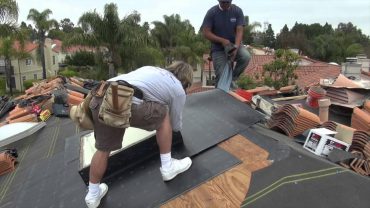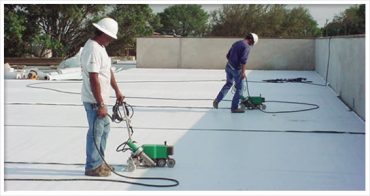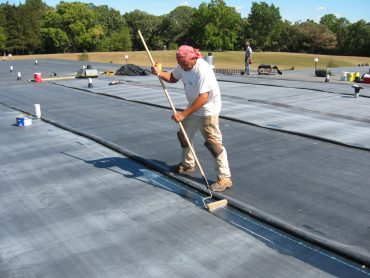
John Bleasby
Putting a lid on flat-roofed homes (Part Two): New alternatives
Canadian ContractorNew rivals for bitumen roofing are proving popular
Flat roofs have been covered in bitumen-based products for decades and still have their role today. However, TPO, EPDM and even PVC have taken an ever-increasing market share away.
Part Two of our Flat Roof series takes a peak at these newer alternatives alternatives.
New varieties of bitumen roofing keep it a popular choice
Although new alternatives are challenging bitumen roofing, it remains the solid incumbent material. As Brian Audia, President of A&G Roofing in Orillia, ON explained to Canadian Contractor, “We use it when the application calls for it. It’s still widely spec’d by engineers and other consultants.” However, those applications are increasingly commercial in nature, for example when the roof deck itself is either concrete or steel, or at higher elevations.

Peel-and-stick bitumen sheet products make it a versatile choice, particular when integrating with older material or around roof top items like skylights
While the torch-down concept of laying down bitumen is somewhat old-school and carries safety risks, there have product developments over the years, and newer and alternate methods of application. “The proper term is ‘modified bitumen’ because it’s asphalt-based and modified with polymers,” says Audia. “Back in the day, modified meant Atactic Polypropylene (APP). It was modified with plastic and was very rigid. You used to put a couple of ply’s down with an aluminized paint over it. Today, it’s modified with Styrene Butadiene Styrene or SBS. It’s essentially a rubber-modified. It’s a lot more versatile, a lot more pliable.”
As a result, Audia maintains that bitumen roofing is not on its way out any time soon. “Specifiers like it because they’re used to it, it’s very reliable, very durable, and dimensionally stable,” he says. It’s also very versatile. Audia explains how, as a multi-ply system consisting of a base sheet and a granular cap sheet, the installation can be tailored to meet the specific needs of the building. “You can put it down with hot asphalt, you can peel-and-stick, you can use cold processing, you can torch it down, you can even mechanically fasten it, then peel-and-stick over that,” he says. “You can put down a two-ply system or a three-ply system. You can do two layers of base sheet and mop the cap sheet, or mop down two layers of base sheet and torch the cap sheet. We can integrate everything.” The resultant durability is important, particular on commercial roofs that are home to various mechanical services that need maintenance or inspection from time to time.

TPO roofing seams are welded with a high temperature heat gun.
TPO and PVC; newer options, each with advantages
Single ply membranes like TPO (Thermoplastic Polyolefin) are increasingly popular since it was introduced in 1989, with tens of millions of square feet installed world-wide. TPO is made from polypropylene and ethylene-propylene rubber, polymerized together, and is available in 3 different thicknesses, 0.045”, 0.060”, and 0.080”. It can be installed either as a fully adhered or mechanically attached system.
Audia estimates that on a revenue basis, TPO represents at least 50 per cent of his business these days. “It’s easier to work with, it’s safer to work with, and you can get a lot more coverage in a shorter period of time.” TPO membrane seams are heat-welded together at 926ºC with a hot-air gun. The result is a fused seam that’s stronger than the field of the membrane. The heating process also allows the product to be shaped and re-shaped as required.
Although a single-ply membrane can be vulnerable to damage from dropped tools, repairs to TPO are simple and durable. The only drawbacks in Audia’s mind relate to the challenge of integration with existing roofing materials, something that takes so much time with TPO that he’d rather just go with a bitumen system. The other issue is the trim metal required when there is no curb or parapet at the roof’s edge. That calls for specialized TPO metal products, which Audia says are very expensive.
However, given that most residential roof deck are wood, not concrete or steel, and that roof traffic on a home is likely to be minimal, it is understandable why TPO has grown so fast in popularity. In terms of warranties for a relatively new product, Audia has few concerns, given the reputations and size of the manufacturing companies. “Commercial manufacturers are putting up 20 to 25 year warranties if you assemble the roof to certain specifications. That’s as good as any modified roof.”
PVC loses eco-points in today’s world
Whereas TPO which contain no toxic or hazardous ingredients and is 100 per cent recyclable, PVC is finding itself increasingly isolated as a roofing choice. Aside from its very high cost, concerns surround the toxic manufacturing process of PVC itself, and the fact that old material is non-recyclable. However, in the case of restaurant or factory roofs where chemical exhaust is present, it’s a superior choice. As a result it would not appear to have much purpose in residential applications, given the other choices.

An EPDM (rubber) roof is laid down with adhesives, and should be installed by a trained installer to maximize the useful life of the system.
EPDM; a fancy way to say ‘rubber’
An EPDM roof (ethylene propylene diene monomer) is a synthetic rubber, single-ply roofing, popular for over 40 years with many contractors because specialized installation equipment is not required. That’s not necessarily a good thing given that, as a result, untrained workers often do the installations, resulting in potential premature failures.
EPDM is made from mostly oil (carbo-hydrate) based by-products with modifiers and stabilizers added to extend its service life — not exactly an environmentally friendly combination. The rolled material is attached to the roof deck with adhesives, with special tape used to seal the seams.
An EPDM roof claims several positive marketing points, however. It is designed to be UV stable and to withstand inclement weather, ozone and heat. It is resistant to tears, punctures, impacts, and normal roof traffic. Also, it can accommodate structural movement, and remains pliable under a wide range of temperature fluctuations. However, Audia cautions against its use on roofs that are not sloped at all and that tend to ‘pond’ easily. “The adhesives on EPDM break down over time. If you bury an EPDM roof under water, the water can leech under the seams and flashing and waffle them; the adhesive then starts to break down,” he explains. This is why he favours TPO over EPDM. “Standing water doesn’t affect TPO the same way as EPDM.”
What about cost?
It’s hard to be precise due the variety of roof layouts and requirements, however for most residential applications, Audia offers this ranking, from most to least expensive: PVC, modified bitumen, TPO, EPDM. Make your choice based the deck material and the specifics of the project, but be informed!
Read Part One of this series:
The risks of a torched-down bitumen roof on combustible decks
Follow John on Instagram and on Twitter for notifications about his newest posts


Leave a Reply